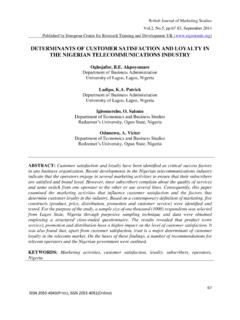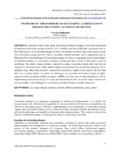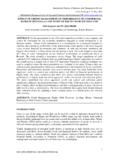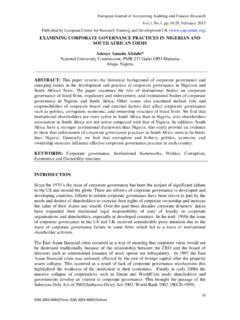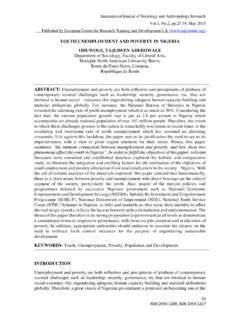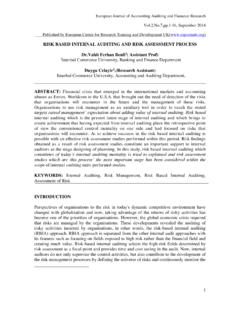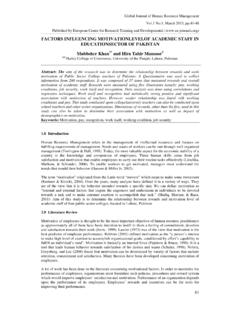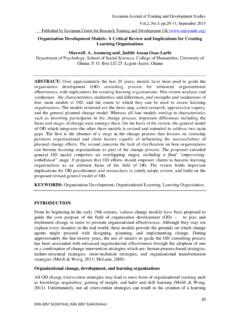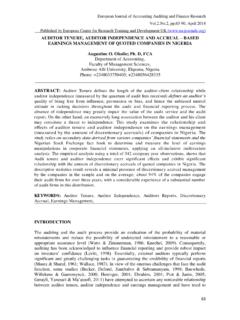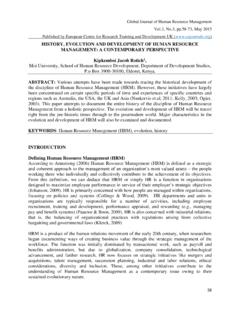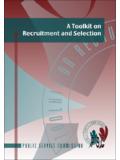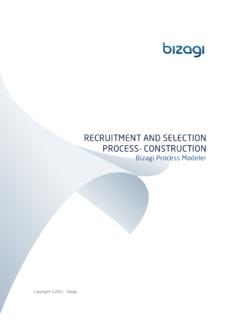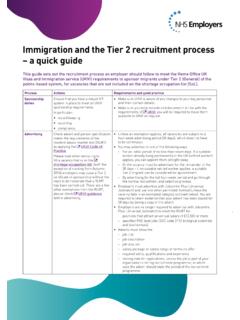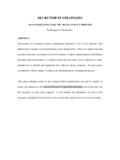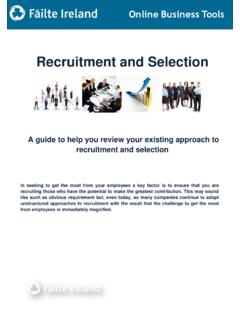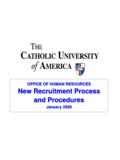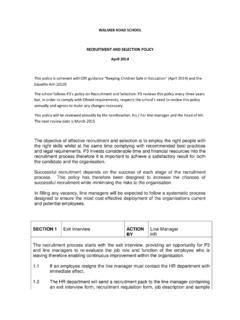Transcription of THE IMPACT OF RECRUITMENT AND SELECTION …
1 Global Journal of Human Resource Management , , , March 2015 Published by European Centre for Research Training and Development UK ( ) 22 ISSN 2053-5686(Print), ISSN 2053-5694(Online) THE IMPACT OF RECRUITMENT AND SELECTION CRITERIA ON ORGANIZATIONAL PERFORMANCE Joy O. Ekwoaba Department of Industrial Relations and Personnel Management University of Lagos Ugochukwu .U. Ikeije Department of Human Resource Management Michael Okpara University of Agriculture, Umudike Ndubuisi Ufoma Department of Industrial Relations and Personnel Management University of Lagos ABSTRACT: This study investigates the IMPACT of RECRUITMENT and SELECTION criteria on performance using Fidelity Bank Plc, Lagos Nigeria as focal point. The analyses of 130 valid responses obtained through a questionnaire that was administered to randomly selected respondents revealed that RECRUITMENT and SELECTION criteria have significant effect on organization s performance (X2 = ; df = 3; p< ).
2 The more objective the RECRUITMENT and SELECTION criteria, the better the organization s performance (X2 = ; df = 4; p< ). KEY WORDS: RECRUITMENT , Organization, SELECTION , Human Resource, Performance. INTRODUCTION One of the most significant developments in the field of organizations in recent times is the increasing importance given to human resource. People are vital to organizations as they offer perspectives, values and attributes to organizational life; and when managed effectively, these human traits can be of considerable benefits to the organization. As revealed in Djabatey (2012) this scenario lends credence to the increasing attention being paid to the people aspect of organizational wealth. This is so because the development of people, their competencies, and the process development of the total organization are the fulcrum of human resource management (Mullins, 1999; Djabatey, 2012).
3 Akin to this development is the contention in National University of Ireland (2006) that the continued growth of the enterprise depends on its ability to recruit and select high quality personnel at all levels. While RECRUITMENT is the process of identifying and attracting potential candidates from within and outside an organization to begin evaluating them for future employment, SELECTION begins when the right calibre of candidates are identified (Walker, 2009). However, most RECRUITMENT and SELECTION processes have elements of subjective judgement inherent in them. But treating job applicants in a professional and positive manner is more likely to leave them, whether they are successful or not, with a positive view of the organization and Global Journal of Human Resource Management , , , March 2015 Published by European Centre for Research Training and Development UK ( ) 23 ISSN 2053-5686(Print), ISSN 2053-5694(Online) how it has dealt with the applicants (National University of Ireland, 2006).
4 Experience also shows that a successful appointment can produce results which IMPACT favourably on the wider aspects of organizational life while a poor one can have damaging effects far outside the organization in which it is made. However, the RECRUITMENT and SELECTION of employees also provides an opportunity for the organization to present itself in a favourable light (National University of Ireland, 2006). Available literature has argued that the success of the enterprise is directly linked to the performance of those who work for that business. By the same token, under-achievement can be a result of workplace failures. Because hiring the wrong people or failing to anticipate fluctuations in hiring needs can be costly, it is important that conscious efforts are put into human resource planning (Biles & Holmberg, 1980; Djabatey, 2012).
5 It has also been argued that in order for the enterprise to build and sustain the competitive advantage, proper staffing is critical (Djabatey, 2012). Thus, RECRUITMENT and SELECTION have become imperative in organizations because individuals need to be attracted on a timely basis, in sufficient numbers and with appropriate qualifications. Therefore, this study sets to examine the effect of RECRUITMENT and SELECTION criteria on performance using Fidelity Bank Plc as population of interest. In order to achieve this objective, we then hypothesized that: i. RECRUITMENT and SELECTION criteria have significant effect on organization s performance ii. The more objective the RECRUITMENT and SELECTION criteria, the better the organization s performance. THEORETICAL FRAMEWORK This study rests on Human Capital Theory, Resource Based View Theory and Equity Theory.
6 Human Capital theory as proposed Adam Smith (1723-1790) in Teixeira (2002) has the central idea that people are fixed capitals just like machine because they have skills and useful abilities that has genuine cost and yields profits. The premise in the human capital theory, according to Armstrong (2006) is that people and their collective skills, abilities and experience, coupled with their ability to deploy these in the interests of the employing organization, are now recognized as making a significant contribution to organizational success and also constituting a significant source of competitive advantage. Resource Based View (RBV) of Barney (1991) suggests that sustainable competitive advantage is attainable when firms have a human resource pool which cannot be imitated or substituted by rivals.
7 According to the Resource-Based view, firms should constantly evaluate their workforce to ensure that they have the right people with the right skills in the right places to ensure sustained competitive advantage (Barney, 2001) and when this is not the case, firms should make-up for the shortfall by employing appropriate RECRUITMENT and SELECTION criteria. The theory maintained that the major part of any firm s strength or weakness stem from the calibre of the people employed and the quality of their working relationships. To this end, Boxall (1998) revealed that firms which recruit and retain exceptional individuals have the capability of generating human capital advantage. According to Sparrow et al., (2002), technology and capital can be acquired by most firms any time, for a price, but it is not easy to acquire a ready pool of highly qualified and motivated employees.
8 Thus, in order to be differentiated, the companies need to be very careful with the RECRUITMENT and SELECTION process. Global Journal of Human Resource Management , , , March 2015 Published by European Centre for Research Training and Development UK ( ) 24 ISSN 2053-5686(Print), ISSN 2053-5694(Online) Equity Theory as proposed by Adams (1963), underlines the principle of fairness. According to the principles of the Equity Theory, the best RECRUITMENT and SELECTION criteria in the organization is that which portrays the firm as Equal Opportunity Employer Finding competent workers is an important organizational challenge (McEvoy, 1984; Deshpande & Golhar, 1994; Atkinson & Storey, 1994), with the difficulty centering on recruiting and selecting employees with the correct qualifications to help achieve goals (Priyanath, 2006).
9 As further argued in Priyanath (2006) this problem is compounded by the lack of systematic method for recruiting and selecting employees. A systematic RECRUITMENT process according to Gamage (2014) involves indentifying vacancies, job analysis, job description, person specification and advertising. As against informal process for recruiting and selecting employees, a systematic SELECTION process involves the recruiting process, gathering information about qualified applicants, evaluating the qualification of each applicant and making decisions about employment (Gamage, 2014). LITERATURE REVIEW RECRUITMENT and SELECTION are vital functions of human resource management for any type of business organization. These are terms that refer to the process of attracting and choosing candidates for employment.
10 The quality of the human resource the firm has heavily depends on the effectiveness of these two functions (Gamage, 2014). Recruiting and selecting the wrong candidates who are not capable come with a huge negative cost which businesses cannot afford. Thus, the overall aim of RECRUITMENT and SELECTION within the organization is to obtain the number and quality of employees that are required to satisfy the strategic objectives of the organization, at minimal cost (Ofori & Aryeetey, 2011). As explained by Opatha (2010) RECRUITMENT is the process of finding and attracting suitably qualified people to apply for job vacancies in the organization. It is a set of activities an organization uses to attract job candidates who have the needed abilities and attitudes. RECRUITMENT is the process of generating a pool of qualified applicants for organizational job vacancies.
